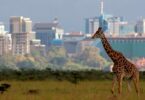The Great Migration has for years remained East Africa’s marvel. It attracts hundreds of tourists every year to Kenya’s Maasai Mara and Tanzania’s Serengeti.
Kenya and Tanzania are the only countries in the world that experience the wildebeest migration. Many consider it the ‘eighth wonder of the world’. Wildebeest Migration is fascinating and brings about the beauty of Africa’s wilderness.
What Month Is The Great Migration in Kenya?

Great wildebeest migration from Serengeti into the Masai Mara – Cedarberg Travel
The Great Migration in Kenya takes place between July and late October. Millions of wildebeest in this ecosystem have an interesting migration cycle.
In February, a dozen calves are born in the Serengeti marking the beginning of the migration to the north in April. By this time, they are nearing the Mara ecosystem towards the Mara-Serengeti border.
In May, the animals are already far up in the north where there is plenty of fresh pasture. Here, there are thousands of zebras and gazelles grazing in Moru Kopjes and Seronera western parts.
Around June, The Grumeti River is a beehive of activities with the wildebeest. There are several blocked passage channels that inhibit movement to the north. This forms the Western Corridor with at least two million wild animals.
They cross over daring the huge crocodiles in Grumeti River. However, it is not near the spectacle seen in the Mara River. The migration goes on July marks another turn when things start picking up in the Maasai Mara.
This is the moment of a lifetime for tourists across the world as they enthusiastically watch things unfold. Herds of wildebeest cross the crocodile-infested river. July to October is a beehive of activities in Maasai Mara National Reserve.
Why you should visit

The Wildebeest Migration in Kenya Facing Extreme Risks – Africa Safari Classics
In general, The Great Migration covers Serengeti National Park, Ngorongoro Conservation Area, Loliondo Game Controlled Area and Grumeti Reserve. In Kenya, the migration stretches to the Maasai Mara Game Reserve, bordering Serengeti National Park in the north.
The best way to enjoy the sight of wildebeest is visiting when the migration is ongoing. The river crossing at the Maasai Mara is the most fascinating of events in the historic wildebeest migration.
The animals graze on the southern banks of the river before one brave wildebeest takes the dive into the river current. The rest follow in a dramatic watery stampede. Some do not make it. The majority of the tourists have considered this as the most desirable phase of the migration.
To maximise your chances of seeing this beautiful action, camp around the river for a week. The herd will then migrate south, to Serengeti, at around November to December. This is another time of the year to witness the crossing of the Mara River.
This is the best time to be in Serengeti National Park, Tanzania. Around this time, the wildebeests move south toward the Ngorongoro Conservation Area. It marks the official is also calving season with 80% of the wildebeest giving birth due to abundance of pasture and water.
Serengeti is an ‘expo’ for one of the most impressive wildlife shows on earth. An estimated two million animals migrate to and from Kenya each year. They have established a popular route now the famous western corridor.
The Great Migration raises curtains on the predatory skill of carnivores in the jungle. Lions, cheetahs and leopards are always on the prowl.
Fact Box
The migration sees over 2 million wildebeest and 200,00 zebras travelling across the two countries, approximately covering 800 km in each cycle
There are around 250,000 wildebeest and 30,000 zebra die every year as a result of predation by carnivores, crocodiles, thirst, hunger and exhaustion.
During the migration, over 3,000 lions follow the herd closely due to the availability of food and easy prey.








